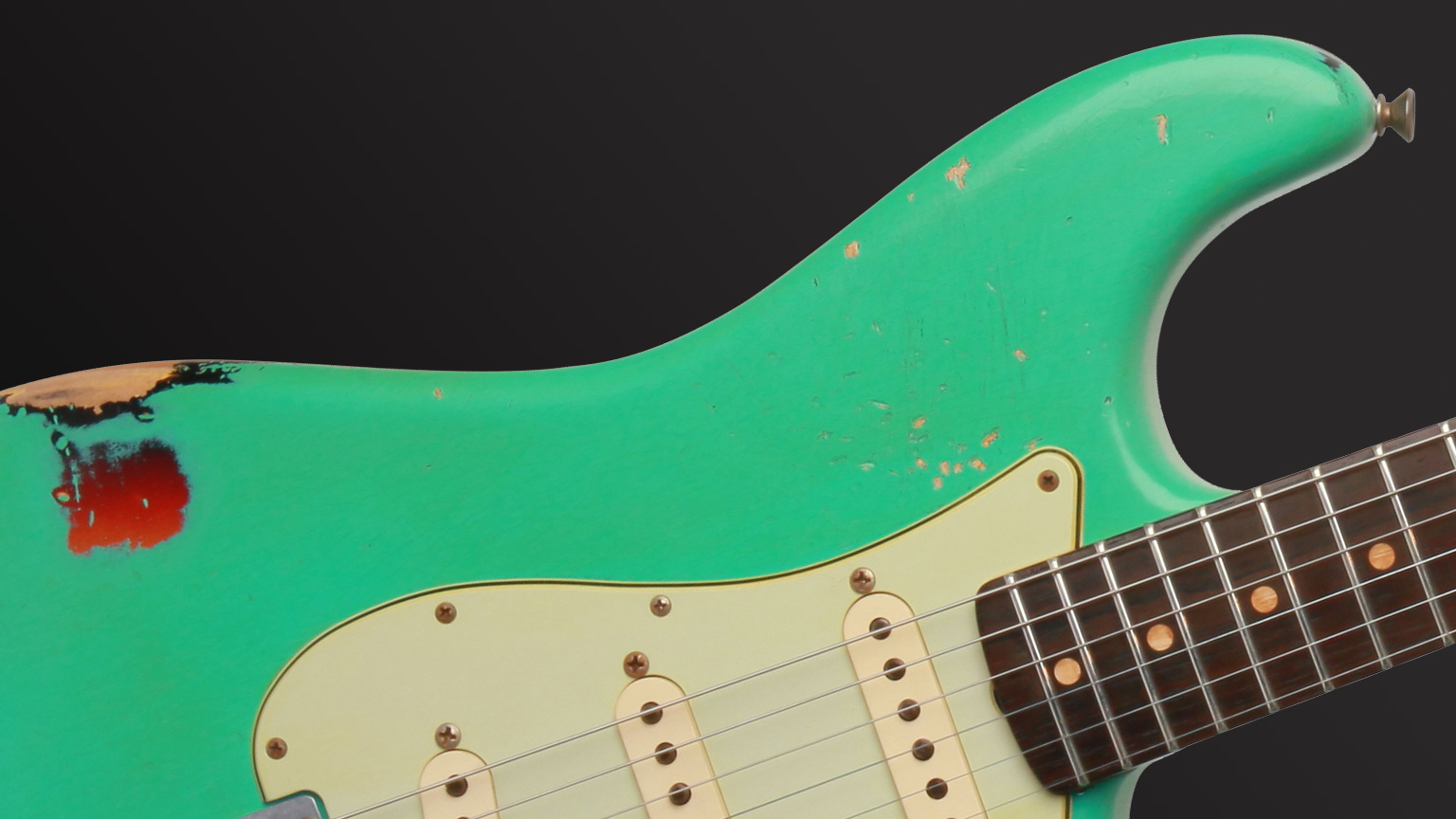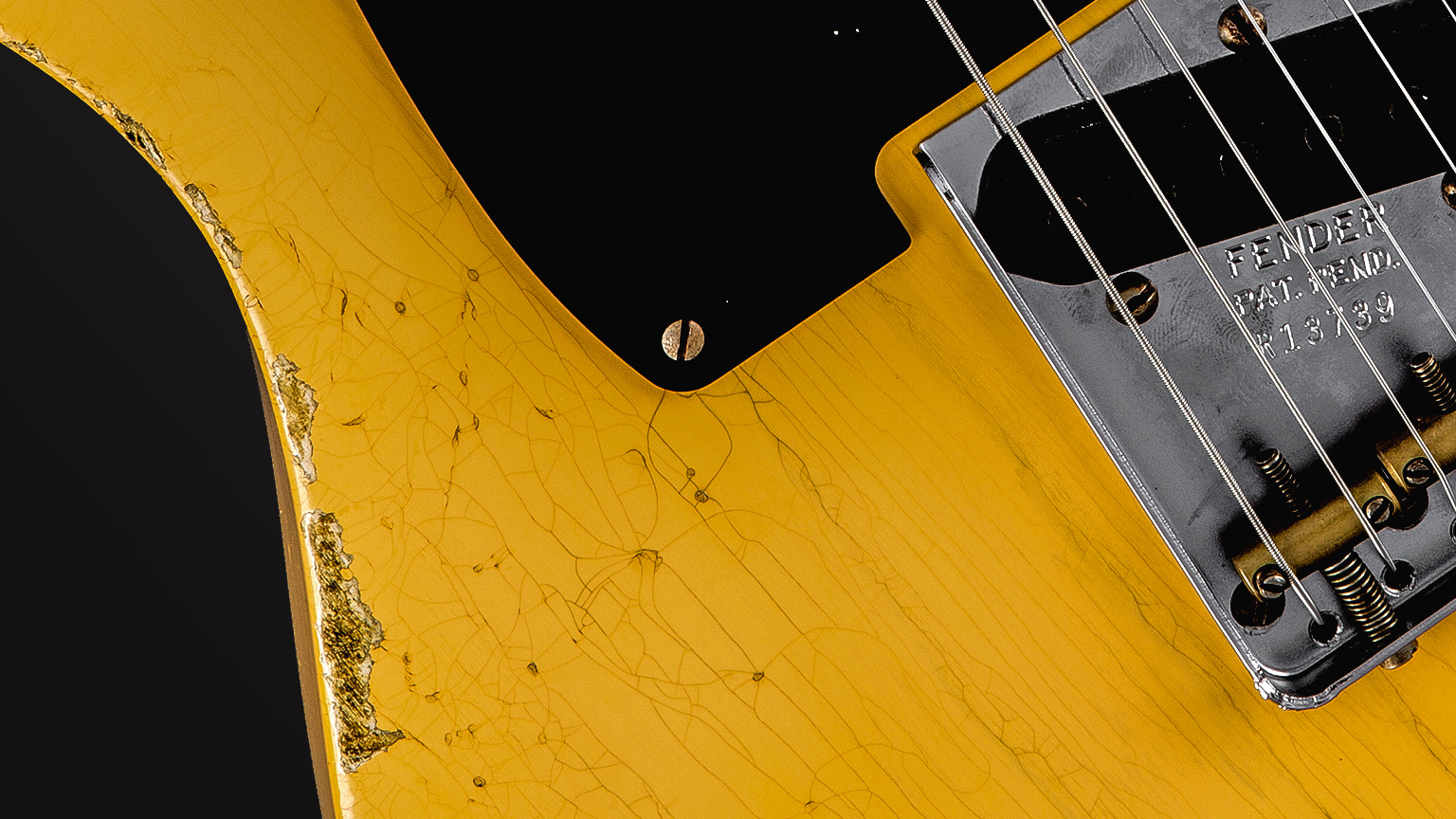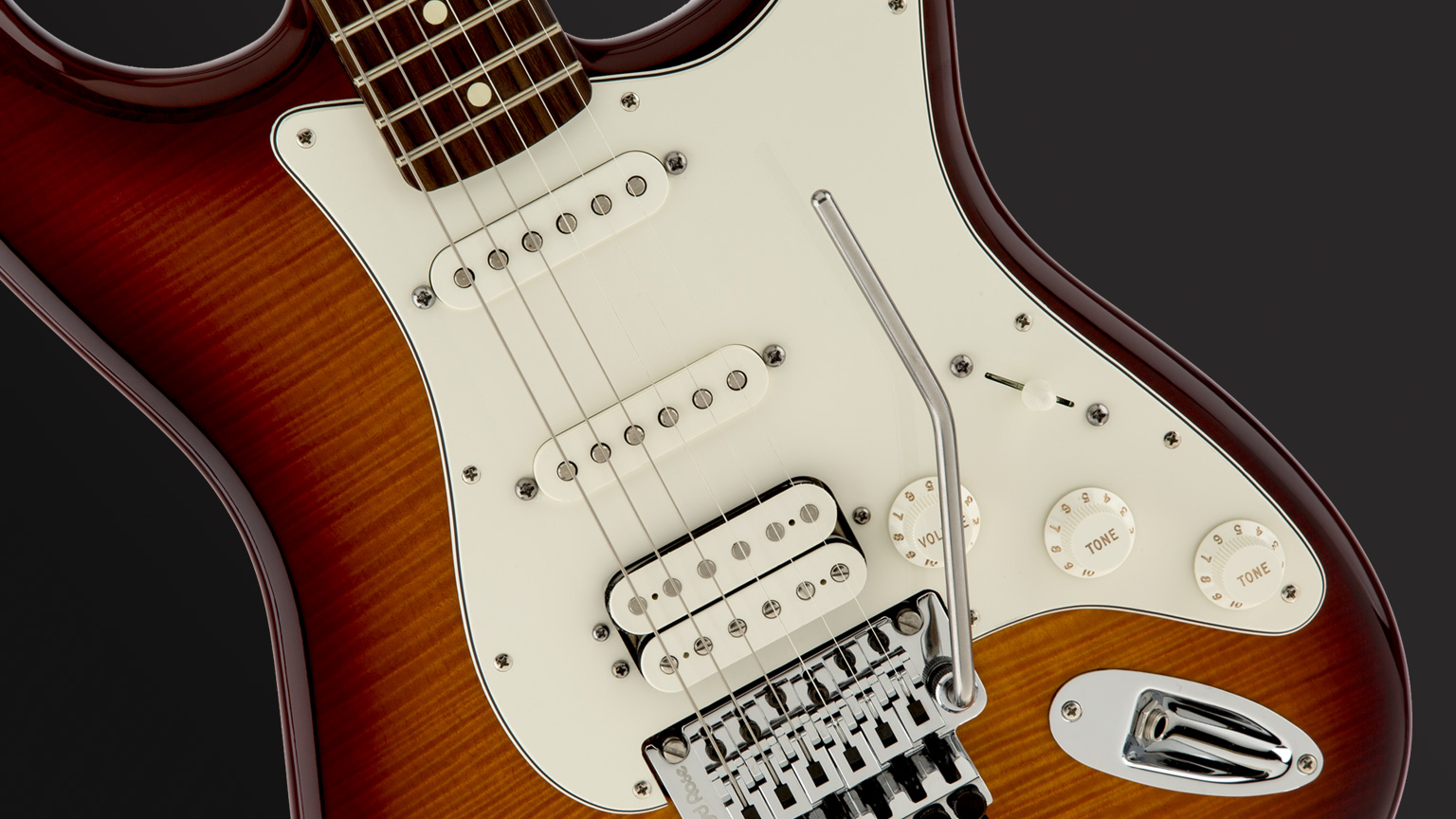Will The 1980s Made In Japan Fender Stratocasters Continue To Increase In Value
Here'southward your primer Into the world of finishes.
A guitar'southward wait is a major part of the argument that guitarists brand to the world well-nigh themselves. Information technology says y'all're absurd, or that you're hot. It says your mode is flamboyant or that it's laid-back. It'due south says you're state-of-art or erstwhile-school; classic or cutting border. It gives the musical instrument a big office of its character and its soul, which, in plow, is a role of what you do and who you are.
By its colour, its pattern and its status—pristine, battered or somewhere in between—the terminate is a defining element of your instrument and your musical identity. Every bit such, it is a manufacturing marvel of both style and substance—there to both personalize and protect your instrument, and but equally much a "function" equally the pickups, neck, bridge, tuners and everything else. It helps give color and life to its await, experience and sound, and it provides protection from all manner of external influences.
Looking for a beginner guitar? Our interactive gear guide, FindYour.Fender.com, matches you with the perfect model past learning about your sound & mode. You'll be well on your mode to finding the correct guitar for you.
Embedded content: https://www.youtube.com/lookout man?five=MKGsPDguCXs&listing=PLoi2sDiBa0Ebpai8seeAy7N2r0REs0m
Both historically and today, a lot of science is involved in end coatings for musical instruments. The substances themselves and their various awarding methods and combinations are enormously circuitous. And information technology definitely bears remembering that these finishes are applied to products fashioned from once-living organic plant matter; namely, wood. Woods is a substance that moves and changes with climate, treatment and age, as practise the finish coatings that are applied to it.
Fender uses a variety of finish types on its instruments, from the original nitrocellulose lacquer finishes used then often in the visitor's 1950s-'60s era (and beloved of vintage guitar enthusiasts) to more than mod urethane and polyester finishes. Suffice it to say that, technically, guitar finishes are no unproblematic matter, merely here's a general primer on modern Fender guitar finishes.
Nitrocellulose Lacquer
Nitrocellulose lacquer ("nitro") was the finish nigh oft used during Fender's original 1950s and '60s gold age, although acrylic lacquers were likewise used. Invented in 1921 past the DuPont chemical company for the machine manufacture, nitro was the first spray-on paint, and it was quickly adopted by the furniture and musical musical instrument industries.

A Fender Custom Store 1963 Stratocaster Relic (above) shows the kind of wearable typically associated with a nitrocellulose lacquer finish, which this musical instrument has. Below, take a wait at a close-up of finish checking on a Fender Custom Shop 1952 Heavy Relic Telecaster.

Although chemically temperamental in the awarding stage, it was hands applied and resulted in a tough, fast-drying thin cease that blended well with natural woods grain, buffed to a beautiful sheen, spot repaired easily and had flexibility that allowed the wood of a guitar to resonate with little restraint (many guitar buffs believe nitro finishes "sound" amend). Early on, Fender took its custom colors straight from General Motors under their original DuPont names and part numbers ("Duco" for nitrocellulose lacquer and "Lucite" for acrylic lacquer).
Nitro finishes, nonetheless, crack and yellow with age, and they tin can "bank check" (guitar-speak for fine hairline cracks) with age or sudden exposure to low temperatures. They get thinner and more breakable as they age because the thinners in them keep to evaporate throughout an instrument'southward lifetime. These characteristics actually concur special appeal for many guitarists, as the great, yellowing, checking and aging common to this finish blazon are exactly what many aficionados love about nitro.
Fender however uses nitrocellulose lacquer finishes on a select group of instruments (Road Worn™ and American Vintage series, various artist models). Variants in use include satin nitrocellulose lacquer (Highway One models, Jim Root Stratocaster), which is a flatter finish, and thin-skin nitrocellulose lacquer (Vintage Hot Rod models), which has a thinner sanding sealer or lacquer undercoat.
Polyurethane
Fender introduced polyurethane finishes (oftentimes shortened to "urethane") on its instruments in the late 1960s; allowing a glossier, more than even finish past replacing multiple layers of nitro clear blanket with a mere two layers of aliphatic urethane.

Above, an American Special Stratocaster with a gloss urethane finish (a type of polyurethane finish). Polyurethane finishes wait great, historic period well and are extremely durable.
Polyurethane was invented in Germany in 1937. A highly versatile plastic, it was introduced into U.S. commercial manufacturing in the 1950s. In liquid plastic resin course, it made an extremely fast-drying, tough and durable end (also used for dance floors and bowling alleys) that formed a much harder and abrasion-resistant layer around a guitar than nitro, while all the same assuasive good wood resonance. Further, urethane ages well—information technology doesn't check, crack and yellow equally nitro finishes do. If you aren't a fan of the shell-upwards await, a urethane-finish instrument is probably for you.
Fender continues to use urethane finishes on many of its instruments (American Standard Series, various artist models), with variants including flatter satin urethane (necks on Palatial, Standard, Highway One, American Palatial and American Standard models) and thicker, shinier gloss urethane (American Specials, Ritchie Blackmore Stratocaster).
Polyester
Fender started using polyester finishes in the 1970s. Thick and difficult, polyester finishes were introduced in several industries that decade—instrument manufacturing included—and apace proved popular.

Higher up, a Standard Stratocaster with a polyester finish. Like polyurethane, polyester finishes look keen, age well and are extremely durable.
The primary advantage of polyester is that it makes for a colorful and extremely tough, durable cease. Polyester guitar finishes age and weather especially well and are seemingly immune to climate and injury—they are highly resistant to scratching and checking, and colors remain remarkably pristine. Sonically, y'all go tones that are more purely those of the pickups rather than other elements of the instrument's construction, which many players prefer.
Every bit with nitro and urethane, Fender continues to use polyester finishes on a number of instruments and instrument families (Classic, Classic Thespian, Deluxe, Standard series, various artist models).
Dorsum in Fender's early days, there was no such thing every bit a vintage guitar market. Those who worked for the small, bustling company in the 1950s and early '60s never dreamed that many of the instruments they were building would ane solar day fetch many thousands of dollars.
It never occurred to them that decades later a nitro end in an advanced stage of historic period and deterioration would assist increase the value of a Stratocaster or a Precision Bass to astronomical heights. It certainly never occurred to them that i twenty-four hour period at that place would be a worldwide network of interconnected reckoner users who would vigorously scrutinize and fence the near arcane Fender finish minutia regarding, say, the sonic qualities of urethane topcoats, the kind of paint sealer used in 1960, whether DuPont'south Lake Placid Blue was slightly "greener" than Ditzler'southward Lake Placid Blue, the slightest inconsistencies in undercoats, the pros and cons of polyester. And on andq on …
The signal is well made, though. Guitar players care about the statement that an musical instrument end makes. They intendance about how it affects an instrument'due south tone, experience, look and value over time. They care about how information technology helps projects personality. For novice, pro and collector alike, at that place is no visual chemical element of a guitar more important than its finish.


Will The 1980s Made In Japan Fender Stratocasters Continue To Increase In Value,
Source: https://www.fender.com/articles/tech-talk/the-science-and-style-of-finishes
Posted by: phillipsinquen.blogspot.com


0 Response to "Will The 1980s Made In Japan Fender Stratocasters Continue To Increase In Value"
Post a Comment